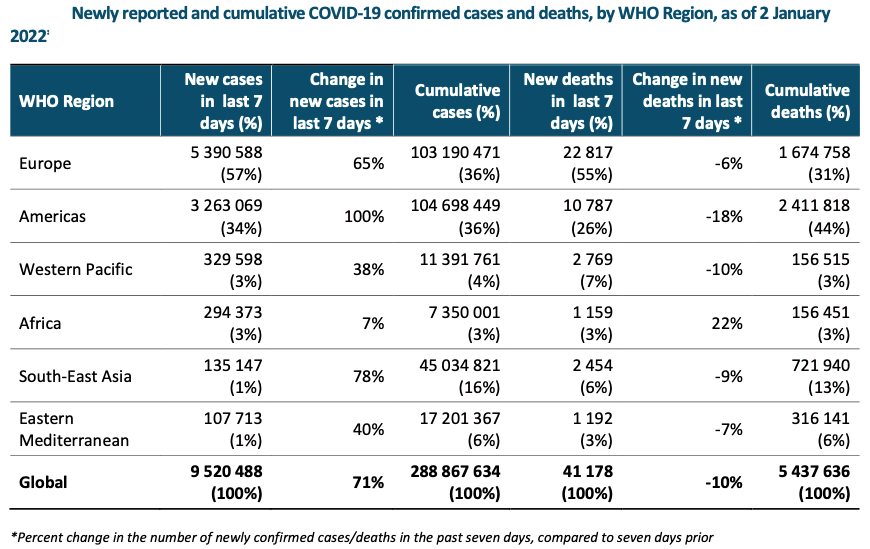
Omicron does appear to be less severe compared to Delta, especially in those vaccinated, it does not mean it should be categorized as ‘mild’ as it is hospitalizing and killing people: WHO
Geneva: The latest figures released today by the World Health Organization (WHO) showed a sharp rise of 71% in global number of news cases of COVID-19 during the week December 27, 2021 to January 2, 2022, as compared to the previous weak. However, the number of new deaths decreased by 10% and the African Region was the only region to report a weekly increase in the number of new deaths (22%). Overall, this corresponds to just under 9.5 million new cases and over 41 000 new deaths reported during the last week, globally.
All WHO regions reported an increase in the incidence of weekly cases, with the Region of the Americas reporting the largest increase (100%), followed by the South-East Asia Region (78%) and the European Region (65%). The African Region reported a weekly increase in the number of new deaths (22%), while all the other regions reported a decrease as compared to the previous week.
As of January 2, a total of nearly 289 million cases and just over 5.4 million deaths have been reported globally. It may be mentioned that there had already been a gradual increase in COVID-19 cases since October 2021.
WHO Director-General Dr. Tedros Adhanom Ghebreyesus told mediapersons today that while Omicron does appear to be less severe compared to Delta, especially in those vaccinated, it does not mean it should be categorized as ‘mild’.
“Just like previous variants; Omicron is hospitalizing people and it is killing people. In fact, the tsunami of cases is so huge and quick, that it is overwhelming health systems around the world. Hospitals are becoming overcrowded and understaffed, which further results in preventable deaths from not only COVID-19 but other diseases and injuries where patients cannot receive timely care,” he said.
Dr. Ghebreyesus said that while the highest number of COVID-19 cases were reported so far in the pandemic last week, this was an underestimate of cases “because reported numbers do not reflect the backlog of testing around the holidays, the number of positive self-tests not registered, and burdened surveillance systems that miss cases around the word”.

During the week, the European Region continued to report the highest incidence of weekly cases (577.7 new cases per 100 000 population), followed by the Region of the Americas (319.0 new cases per 100 000 population). Both regions also reported the highest weekly incidence in deaths of 2.4 and 1.1 per 100 000 population, respectively, while all other regions reported <1 new death per 100 000.
The highest numbers of new cases were reported from the United States of America (2 556 690 new cases; 92% increase), the United Kingdom (1 104 316 new cases; 51% increase), France (1 093 162 new cases; 117% increase); Spain (649 832 new cases; 60% increase) and Italy (644 508 new cases; 150% increase).
The highest numbers of new deaths were reported from the United States of America (8004 new deaths; 2.4 new deaths per 100 000; a 22% decrease), followed by the Russian Federation (6300 new deaths; 4.3 new deaths per 100 000; a 10% decrease), Poland (3265 new deaths; 8.6 new deaths per 100 000; a 15% increase), India (2088 new deaths; <1 new death per 100 000; an 8% decrease), Germany (1791 new deaths; 2.2 new deaths per 100 000; a 16% decrease), and Viet Nam (1603 new deaths; 1.6 new deaths per 100 000; similar to the previous week).
– global bihari bureau






Great info. Lucky me I discovered your site by accident (stumbleupon).
I’ve bookmarked it for later!